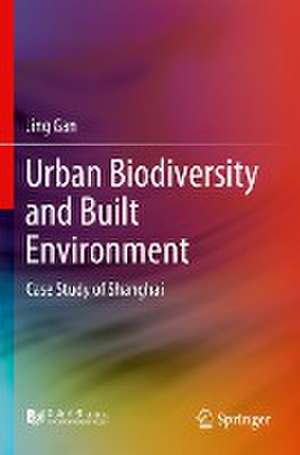Urban Biodiversity and Built Environment: Case Study of Shanghai
Autor Jing Ganen Limba Engleză Paperback – 22 apr 2022
This book proposes the concept of urban multiple habitats and then analyzes its corresponding classification, function and potential supply capability. It provides an analysis framework for studying the relationship between urban biodiversity and built environment, and for considering the loss of urban habitats caused by high-density development. It argues that urban biodiversity is a key indicator for assessing urban ecosystem services.
On this basis, the book then presents a case study mainly focusing on wild birds in Shanghai, as urban wild birds and their species could be viewed as an essential indicator for evaluating healthy ecosystem of contemporary cities. Based on the empirical findings, the book proposes an assessment model for urban biodiversity performance and a range of principles, strategies and key indicators regarding the optimization of urban planning and design practice to enhance urban biodiversity performance.
| Toate formatele și edițiile | Preț | Express |
|---|---|---|
| Paperback (1) | 935.67 lei 43-57 zile | |
| Springer Nature Singapore – 22 apr 2022 | 935.67 lei 43-57 zile | |
| Hardback (1) | 947.04 lei 43-57 zile | |
| Springer Nature Singapore – 21 apr 2021 | 947.04 lei 43-57 zile |
Preț: 935.67 lei
Preț vechi: 1141.06 lei
-18% Nou
Puncte Express: 1404
Preț estimativ în valută:
179.06€ • 185.81$ • 149.66£
179.06€ • 185.81$ • 149.66£
Carte tipărită la comandă
Livrare economică 17-31 martie
Preluare comenzi: 021 569.72.76
Specificații
ISBN-13: 9789811609510
ISBN-10: 9811609519
Ilustrații: XXVI, 195 p. 98 illus., 87 illus. in color.
Dimensiuni: 155 x 235 mm
Greutate: 0.32 kg
Ediția:1st ed. 2021
Editura: Springer Nature Singapore
Colecția Springer
Locul publicării:Singapore, Singapore
ISBN-10: 9811609519
Ilustrații: XXVI, 195 p. 98 illus., 87 illus. in color.
Dimensiuni: 155 x 235 mm
Greutate: 0.32 kg
Ediția:1st ed. 2021
Editura: Springer Nature Singapore
Colecția Springer
Locul publicării:Singapore, Singapore
Cuprins
Introduction.- Conceptual Framework.- Relationship between urban biodiversity and built environment and in macro scale: The case study of Shanghai, China.- Relationship between diversity and built environment in micro scale: The case study in blocks along Century Avenue, Pudong New District, Shanghai.- Urban planning and design optimization approaches to support biodiversity.- Conclusion and future prospect.
Notă biografică
Jing Gan is Associate Professor at the College of Architecture and Urban Planning, Tongji University. She is Member of The Society for Urban Ecology (SURE), Member of China Green Building Council, Member of the Chinese Society for Urban Studies’ Eco-city Research Committee, Member of Ecological Society of Shanghai, and Henry Luce Visiting Scholar at Trinity College, USA. Her main research interests include urban ecological planning and design, urban biodiversity and built environments. She has served as PI for research projects sponsored by the National Natural Science Foundation, Ministry of Education, Ministry of Housing and Urban-Rural Development, WWF and TNC and has participated in more than 10 national and provincial-level projects as a key researcher.
Textul de pe ultima copertă
This book proposes the concept of urban multiple habitats and then analyzes its corresponding classification, function and potential supply capability. It provides an analysis framework for studying the relationship between urban biodiversity and built environment, and for considering the loss of urban habitats caused by high-density development. It argues that urban biodiversity is a key indicator for assessing urban ecosystem services.
On this basis, the book then presents a case study mainly focusing on wild birds in Shanghai, as urban wild birds and their species could be viewed as an essential indicator for evaluating healthy ecosystem of contemporary cities. Based on the empirical findings, the book proposes an assessment model for urban biodiversity performance and a range of principles, strategies and key indicators regarding the optimization of urban planning and design practice to enhance urban biodiversity performance.
Caracteristici
Discusses the relationship between urban biodiversity and built environments in China’s metropolitan cities Presents empirical research based on data gathered in Shanghai, offering valuable reference material for readers interested in related issues Helps practitioners integrate urban biodiversity into planning processes
